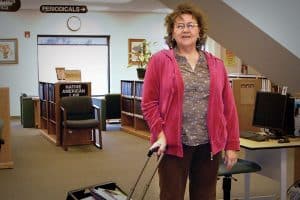
What should outreach to tribal libraries look like? What type of funding is available for these institutions? What considerations must be taken regarding tribal culture and state and federal laws?
At “Perspectives on Outreach to Tribal Libraries,” a February 28 program at the Public Library Association’s 2020 Conference in Nashville, librarians from tribal libraries and the state libraries that support them offered tips for successful collaboration.
Have a purpose. Are you from a state or public library that wants to reach out and network with a tribal library in your area? “Definitely pause and consider your intentions and be honest about them,” said Janessa Esquivel, library media technician for the Confederated Tribes of the Colville Reservation in northern Washington. The initiative should be a true partnership, with both parties involved from the beginning. What people should definitely not do, Esquivel said, is ask tribal libraries for free labor and cultural consultation.
Do your homework. Tribal libraries are not monolithic, nor are the reservations they’re on. “My tribal library is run by the tribal government, but that’s not the case for all tribal libraries,” said Esquivel. Added Carolyn Petersen, Washington State Library’s tribal library consultant: “Not every tribe has a tribal library,” and the ones that do might have wildly different priorities or features. For instance, Jamestown S’Klallam Tribal Library has ethnobotanical programming, Lower Elwha Klallam Tribe’s library puts an emphasis on afterschool programs and helping adults with internet resources, and the Quinault Indian Nation tribal library is part of its museum and cultural center. Respecting tribal sovereignty on any reservation is paramount. “Just know that tribal nations are experts in their own affairs,” said Esquivel.
Know the past—and stay current. “There’s been a long history of how government has worked and not worked with tribal communities,” said Mary Villegas, tribal and technology consultant for the Arizona State Library. For her, knowing key court cases and how tribal law and culture intersects with state and federal laws helps her provide targeted resources to communities. She also recommends anyone who wants to do this kind of work tap into resources like the Association of Tribal Archives, Libraries, and Museums and its conferences; the National Congress of American Indians; review blog American Indians in Children’s Literature; tribal radio stations and newspapers; and the website Oyate. Beyond the reading material, “I try to make as many face-to-face meetings as possible,” Villegas adds.
Find the money. Tribal libraries are eligible for basic and enhancement grants through the Institute of Museum and Library Services (IMLS), as well as grants from the Library Services and Technology Act. “In the 10 years I’ve been with Ak-Chin, [I have] so far have received almost $150,000 in grant money through IMLS,” said Melanie Toledo, library manager of the Ak-Chin Indian Community Library in Arizona. Through this money, she has been able to purchase many tech enhancements for her patrons, including an Aquos Board used in genealogy workshops, Wi-Fi hotspots, a makerspace and green room, and a book bike that is pedaled out to Saturday events and the elder center. Over in Washington, Petersen calls every tribal community that doesn’t yet have a library to remind them of these funds. “‘Did you know there’s a basic grant you can get from IMLS?’ I call them yearly,” she said.


